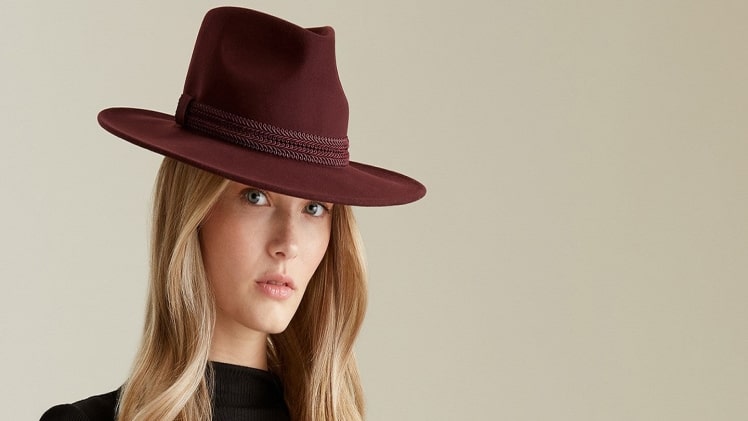A felt hat is a millinery product fashioned from felt, a textile made from wool and hair. More rounds in shape than a top hat, felt hats for women often feature a wide brim.
A history of felt hats for women:
- During the early 20th century, felt became more popular as an alternative to traditional felt fabrics, such as felt or straw. Felt hats are now typically worn with casual or business attire.
- A felt hat is shaped by blocking, shaping the felt into place using heat and moisture. The block is a rectangular piece of metal with depressions in it (called “blocks”), which are slightly wider than the intended brim width and fitted to the size of one’s head; each depression creates a dent where pressure will be applied with either fingers or a tool to shape the felt. The felt is dampened with water, pressed onto the block, left for approximately fifteen minutes until dry enough to keep its new shape without additional support, and then dried overnight. Once dry, they are ready for trimming and decorating. Felt hats may include embellishments such as flowers or ribbon banding that can be attached using an adhesive, or the felt may be left plain.
- Felt hats for women began to rise in popularity during the 1910s; felt fabric became more popular because it was used during wartime to make military headgear like helmets and gas masks. It was also used in men’s felt hats but felt hats for women exhibited femininity through decorations such as ribbon banding. During the 1940s felt hat production declined due to competition from other milliners; however, felt hats remained popular into the 1950s. The felt hat has experienced resurgence in popularity since the late 20th century due to its casual styling and affordability when compared with similar millinery products.
- Felt is made by matting, condensing, and pressing together wool fibers using water, heat, and pressure. The felt has been made for centuries from wool. In Neolithic times, the felt was formed by simply pressing the wool into a round shape before drying.
- In the 19th century felt was made by mixing shredded rags with shoddy (new wool which is a by-product of mechanical processing) and hair; this mixture had to be moistened in order to create felt. Milliners referred to this as “wool felt”. Shoddy felt also contains oils released from the skin of sheep that were not removed during delousing before shearing. These oils may cause yellow discoloration on the felt over time.
- Straw felt is made by matting, condensing, and pressing together straw fibers using water, heat, and pressure. The felt has been made for centuries from cotton or linen; however, in the late 19th century it was made from oiled linen or cotton felt covered with starch sizing.
- A felt hat is shaped by blocking, shaping the felt into place using heat and moisture. The felt is dampened with water, pressed onto a head block, left for 15 minutes until dry enough to keep its new shape without additional support, and then dried overnight. Once dry they are ready for trimming and decorating. Felt hats may include embellishments such as flowers or ribbon banding that can be attached using an adhesive, or the felt may be left plain.
- Traditionally felt was made by matting and condensing, but millinery felt is now more often produced on a loom where it can be interlaced with threads of any colour to produce felt of the required shape and size. These machines were invented in 1826 by John Thor burn, but felt hats were being made earlier than that without the use of looms; some claim Mary Shelley wore such a hat when she wrote Frankenstein.
- A felt hat is shaped by blocking, shaping the felt into place using heat and moisture. The felt is dampened with water, pressed onto a head block, left for 15 minutes until dry enough to keep its new shape without additional support, and then dried overnight. Once dry they are ready for trimming and decorating. Felt hats may include embellishments such as flowers or ribbon banding that can be attached using an adhesive, or the felt may be left plain.
- Traditionally felt was made by matting and condensing, but millinery felt is now more often produced on a loom where it can be interlaced with threads of any colour to produce felt of the required shape and size. These machines were invented in 1826 by John Thornburg, but felt hats were being made earlier than that without the use of looms; some claim Mary Shelley wore such a hat when she wrote Frankenstein.
Conclusion:
A woman’s “felt hat” is the original women’s headwear. The history of women’s hats encompasses several different styles, all of which can be referred to as “felt hats.” The first version of the felt hat was created during the 18th century by combining felt and felt, and then blocking to shape. This style of felt hat has been in fashion throughout history. Nowadays felt hats are not only made from felt but also by machines that interlace threads of any colour to produce felt of the required shape and size.

